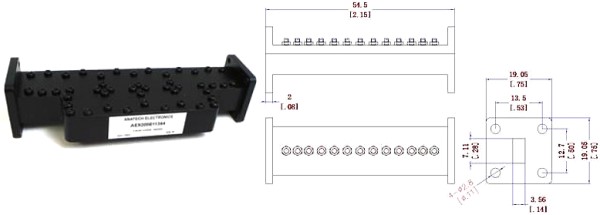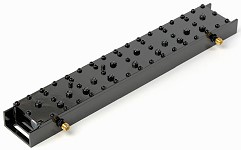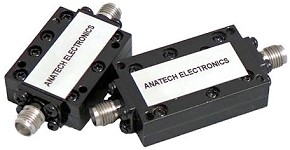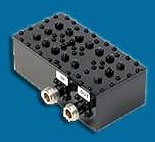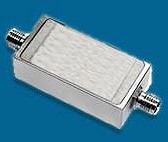Anatech Electronics May 2021 Newsletter |
||

Press Release Archives: 2024 | 2023 | 2022 | 2021 |2020 2019 | 2018 | 2017 | 2016 | 2015 2014 | 2013 | 2012 | 2011 | 2010 2009 | 2008 | 2007 | 2006 | 2005 Content is copyright of company represented. Page format, custom text and images are RF Cafe copyright - do not distribute.
Sam Benzacar of Anatech Electronics, an RF and microwave filter company, has published his May 2021 newsletter that features his short op−ed entitled "More Interference to Come – in Vehicles," where he discusses the increasingly hostile electromagnetic environment present in and around cars and trucks as wireless electronics gains an ever increasing presence. Says Sam, "This problem will only worsen with the 'digitalization' of vehicles that, in the not-too-distant future, will make them rolling IoT platforms." I like that rolling IoT platforms comment. Fortunately, the art and science of RF filter design and manufacturing is advancing to enable coexistence of multiple platforms - at least for now - and Anatech is at the front line of the battle. Sam also presents some relevant industry news items as well. A Word from Sam Benzacar More Interference to Come – in Vehicles
The need to keep electromagnetic energy in check has been crucial since Henry Ford's production line started rolling. Over the years, sources of electrical and electromagnetic interference have multiplied, and the result is an environment rich with signals spanning very low frequencies to the microwave region that can, in the worst cases, render a vehicle immobile or cause a critical subsystem to malfunction. This problem will only worsen with the "digitalization" of vehicles that, in the not-too-distant future, will make them rolling IoT platforms. As always, EMI and RF and microwave filters will be the basic interference cancellation solution. Consider that in today's vehicles there are multiple signal buses, up to 150 electronic control units (ECUs), and various wireless communications systems (such as navigation, Wi-Fi, and cellular), as well as radar, cameras, ultrasonic sensors, keyless entry, and infotainment systems. And every one is a potential contributor to or recipient of EMI or RFI, and this list covers just the internal systems and not external interference caused by power lines and other electrical systems, and cellular and other communications systems. What's more, all radio transmitters and other RF components can emit not just the desired frequency but others, typically at lower signal strengths but still strong enough to cause problems. And now electric vehicles are beginning to appear in larger numbers. The heart of an EV is the powertrain, called an electric drive unit (EDU), that consists of an electric motor, a power electronics module, and a transmission. This integrated solution solves some important EMI problems because it brings together three main vehicle components, reducing the amount of high-voltage cable and replacing it with a busbar approach. However, as everything in the vehicle will be electrical or electronic, interference sources may actually increase. After EVs will ultimately come autonomous vehicles that will use more sensors and wireless systems and will be processing and transferring data up to 10 Gb/s that translates into an operating frequency around 5 GHz, so signals at least this high frequency must be attenuated. So, while the auto industry is reinventing itself it is bringing along all the interference sources (and more) that have in most cases been solved by filters. Anatech has been solving all these types of automotive interference problems for more than three decades, so if you're designing a communication system, involved in EW, have interference coming from an RF source, or involved in the RF section of vehicle electrical or electronic systems, and need a solution, we're here to listen, and find a solution. Below are same links to products that helps Technically RF filters are in most cases specifically designed as a narrow band frequency selective device in the design of communication systems or to remove interference coming from a co-site Transmitter, Satellites, Wireless Communication site. We can always find a solution! Standard Band Pass Filters library
Verizon Launches Private 5G Network
Magnets in Phones Affect Medical Implants
EW Market to Reach $23.5 Billion by 2028
Getting Ready for 5G: Anatech Electronics introduce New Ka band 30.5 GHz Waveguide Band Pass Filter. Featuring a center frequency of 30.5 GHz, a bandwidth of 1000 MHz, an Insertion Loss 1 dB Max, and a Power Handling is 20 watts.
Anatech Electronics Introduces a New Line of Suspended Stripline and Waveguide Type RF Filters
Check out Our Filter Products
Cavity Band Pass Filters LC Band Pass Filters Cavity Bandstop/Notch Filter About Anatech Electronics Anatech Electronics, Inc. (AEI) specializes in the design and manufacture of standard and custom RF and microwave filters and other passive components and subsystems employed in commercial, industrial, and aerospace and applications. Products are available from an operating frequency range of 10 kHz to 30 GHz and include cavity, ceramic, crystal, LC, and surface acoustic wave (SAW), as well as power combiners/dividers, duplexers and diplexers, directional couplers, terminations, attenuators, circulators, EMI filters, and lightning arrestors. The company's custom products and capabilities are available at www.anatechelectronics.com. Contact: Anatech Electronics, Inc. 70 Outwater Lane Garfield, NJ 07026 (973) 772-4242
Posted June 24, 2021 |
||

 By Sam Benzacar
By Sam Benzacar On Site 5G, Verizon's
first private 5G network indoor or outdoor facilities is managed by Verizon and
delivers the company's "5G Ultra-Wideband" capabilities for high-speed, high-capacity,
low-latency connectivity. It combines 5G small cells with the LTE packet core and
interconnects with the organization's LAN infrastructure. The company has previously
built custom solutions for Corning, Marine Corps Air Station (MCAS) Miramar, the
University of Michigan, Tyndall Air Force Base.
On Site 5G, Verizon's
first private 5G network indoor or outdoor facilities is managed by Verizon and
delivers the company's "5G Ultra-Wideband" capabilities for high-speed, high-capacity,
low-latency connectivity. It combines 5G small cells with the LTE packet core and
interconnects with the organization's LAN infrastructure. The company has previously
built custom solutions for Corning, Marine Corps Air Station (MCAS) Miramar, the
University of Michigan, Tyndall Air Force Base.  iPhones with wireless
charging such as the iPhone 12 Pro Max can interfere with implanted pacemakers and
implantable defibrillators, according to a recent study. The implantable devices
respond to external magnetic sources and the phones have of magnets used for interacting
with the charging base. This generates a magnetic field that can affects the implanted
devices. In the study, an iPhone 12 Pro Max inhibited the action of a defibrillator
when held over the patient's chest and also modified the pacing of a pacemaker.
It's a safe bet that this also applies to any phone with wireless charging.
iPhones with wireless
charging such as the iPhone 12 Pro Max can interfere with implanted pacemakers and
implantable defibrillators, according to a recent study. The implantable devices
respond to external magnetic sources and the phones have of magnets used for interacting
with the charging base. This generates a magnetic field that can affects the implanted
devices. In the study, an iPhone 12 Pro Max inhibited the action of a defibrillator
when held over the patient's chest and also modified the pacing of a pacemaker.
It's a safe bet that this also applies to any phone with wireless charging. 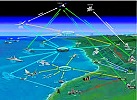 A report published
by Allied Market Research says the global electronic warfare market generated $15.8
billion last year and will reach $23.56 billion by 2028, a growth rate of 5.6%.
The airborne segment had the greatest market share last year and is projected to
register the highest increase (6.1%) during the forecast period. Although the U.S.
was the biggest market in 2020 accounting for about one one-third of it, Asia-Pacific
is expected to register the highest growth through 2028.
A report published
by Allied Market Research says the global electronic warfare market generated $15.8
billion last year and will reach $23.56 billion by 2028, a growth rate of 5.6%.
The airborne segment had the greatest market share last year and is projected to
register the highest increase (6.1%) during the forecast period. Although the U.S.
was the biggest market in 2020 accounting for about one one-third of it, Asia-Pacific
is expected to register the highest growth through 2028. 